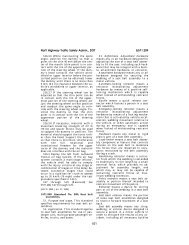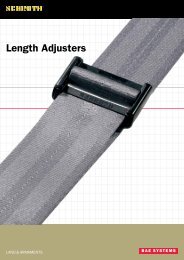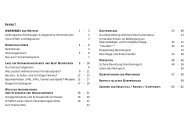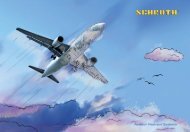Page 1 SFI SPECIFICATION 16.1 EFFECTIVE: FEBRUARY 9, 2006 ...
Page 1 SFI SPECIFICATION 16.1 EFFECTIVE: FEBRUARY 9, 2006 ...
Page 1 SFI SPECIFICATION 16.1 EFFECTIVE: FEBRUARY 9, 2006 ...
Create successful ePaper yourself
Turn your PDF publications into a flip-book with our unique Google optimized e-Paper software.
<strong>SFI</strong> <strong>SPECIFICATION</strong> <strong>16.1</strong> <strong>EFFECTIVE</strong>: <strong>FEBRUARY</strong> 9, <strong>2006</strong> *PRODUCT: Driver Restraint Assemblies1.0 GENERAL INFORMATION1.1 This <strong>SFI</strong> Specification establishes uniform test procedures and minimumstandards for evaluating and determining performance capabilities for DriverRestraint Assemblies used by individuals engaged in competitivemotorsports.1.2 The procedures, test evaluations and standards contained herein, areintended only as minimum guidelines for construction and evaluation ofproducts. Certification that products meet such minimum standards is madeby the product manufacturer and products are not certified, endorsed orapproved by <strong>SFI</strong> under this program.1.3 Use of the "This Manufacturer Certifies That This Product Meets <strong>SFI</strong>Specification <strong>16.1</strong>" logo/designation, the authorized artwork style, orconventional lettering by a manufacturer, on a subject product, is intendedonly to indicate that the manufacturer of the product has represented thatthey have submitted the product to the recommended tests, with positiveresults, in compliance with the standards established herein.1.4 This <strong>SFI</strong> Specification requires a demonstration that the product of amanufacturer meets or exceeds the requirements when the manufacturerenters the program; and on an annual basis thereafter. Any manufacturermay participate in the program by providing Driver Restraint Assemblies thatmeet or exceed the <strong>SFI</strong> Specification <strong>16.1</strong> test standards, by complying withthe requirements of the <strong>SFI</strong> Specification <strong>16.1</strong> program, and by signing alicensing agreement with the <strong>SFI</strong> Foundation, Inc.<strong>SFI</strong> Specification <strong>16.1</strong> <strong>Page</strong> 1 Effective: February 9, <strong>2006</strong>Copyright © <strong>2006</strong> by the <strong>SFI</strong> Foundation, Inc. All rights reserved. Reproduction in any form without written permission of <strong>SFI</strong> is prohibited.
1.5 Compliance with this specification is entirely voluntary. However, when amanufacturer provides Driver Restraint Assemblies in compliance with allrequirements of the <strong>SFI</strong> Specification <strong>16.1</strong> and enters into the licensingagreement with the <strong>SFI</strong> Foundation, Inc., they may certify that compliancewith such standards is in accordance with the guidelines established herein.1.6 Manufacturers wishing to participate in the program, in addition to the otherrequirements of this specification, must label each of their products with themanufacturer's name, trademark or symbol as well as the date ofmanufacture of the product.1.7 No manufacturer may display the <strong>SFI</strong> logo/designation on their productunless the manufacturer has signed a licensing agreement with <strong>SFI</strong> and hassuccessfully complied with all the requirements of this specification and theself-certification program.2.0 DEFINITIONS2.1 A Driver Restraint Assembly is used to secure the user within a vehicle rollcage or cockpit structure with the objective of minimizing injury duringaccident conditions.2.2 Driver Restraint Assembly: An assembly that includes a lap belt, shoulderharnesses, anti-submarine strap and an optional cross strap with theirassociated attachment, adjustment and mounting hardware.2.3 Lap Belt: A belt assembly intended to restrain movement of the pelvis. Itincludes a connection/release buckle along with adjustment and mountinghardware.2.4 Shoulder harness: A belt assembly, one strap for each shoulder, intended torestrain movement of the upper torso and shoulder regions. It includesadjustment and mounting hardware. Optional cross strap can be used tohold the shoulder harnesses together and if the cross strap is in front of thedriver it must be capable of being released in a single motion. A Y-typeshoulder harness, i.e. both shoulder straps become a single strap with oneattachment point, is not permitted. (Effective January 1, 2005)2.5 Anti-Submarine Strap: A belt assembly intended to prevent slippage of thepelvic region forward from under the lap belt during any condition producing aforward pelvic load. This strap can have various configurations. It can havea single mounting, with the other end attached at the buckle (five point) or itcan be mounted at both ends with the attachment to the buckle betweenthem (six point).<strong>SFI</strong> Specification <strong>16.1</strong> <strong>Page</strong> 2 Effective: February 9, <strong>2006</strong>Copyright © <strong>2006</strong> by the <strong>SFI</strong> Foundation, Inc. All rights reserved. Reproduction in any form without written permission of <strong>SFI</strong> is prohibited.
2.6 Buckle: A connector which attaches the lap belt straps together. It alsoconnects the anti-submarine and shoulder harness straps to the lap belt. Itmust have the capability for easy, quick release in an emergency situation.The buckle may have any configuration that meets the requirements of thespecification.2.7 Latch/Lever: A type of buckle release mechanism that utilizes a lever thatopens away from the body. It releases by pivoting in a plane parallel to thelap belt.2.8 Turn/Push: A type of buckle release mechanism that utilizes a militaryparachute design where the mechanism is first turned, in one direction only,and then pushed toward the body to release.2.9 Cam Lock: A type of buckle release mechanism that typically utilizes acircular handle and/or raised surface that turns in either direction to release.2.10 Adjustment Hardware: The hardware used for adjusting the length of theindividual straps to fit the user including such hardware that may be integralwith a buckle or mounting hardware.2.11 Mounting Hardware: The hardware used for securing the individual straps ofthe restraint assembly to the vehicle.2.12 The useful life of the webbing in the straps shall not exceed two years andthey must be replaced at or before that time. Only the original manufacturercan re-web an assembly prior to re-certifying.2.13 Body Block: A device constructed of wood, metal or any other appropriatecombination of materials which approximates the torso of an average sizemale and be adequately designed to withstand all driver restraint assemblytest loads prescribed in this spec. The Body Block shall conform to alldimensions and descriptions, including the cloth covering, described in Figure2 of this specification.2.14 Any restraint assembly pertaining to this specification shall remain asconstructed by the original manufacturer and shall not be modified or alteredby any one else.<strong>SFI</strong> Specification <strong>16.1</strong> <strong>Page</strong> 3 Effective: February 9, <strong>2006</strong>Copyright © <strong>2006</strong> by the <strong>SFI</strong> Foundation, Inc. All rights reserved. Reproduction in any form without written permission of <strong>SFI</strong> is prohibited.
3.0 CONSTRUCTION3.1 HARDWAREAll hardware which contacts the user, his clothing, or the strap webbing shall be freefrom burrs and sharp edges and shall be so designed and located in the assemblythat the possibility of injury to the occupant shall be minimized.3.1.1 BUCKLE RELEASE MECHANISMA. The mechanism shall be designed to minimize the possibility ofaccidental release.B. The mechanism shall be capable of being easily releasedregardless of body attitude (hanging inverted, on side, etc.).C. The mechanism shall be a quick release connector with nomore than two separate motions required to release the entirerestraint assembly.D. The mechanism shall be capable of being easily released inany of the release directions by an individual wearing drivinggloves and not able to see the mechanism.3.1.2 ADJUSTMENT HARDWAREThe driver restraint assembly shall be capable of snug adjustment by theuser by means easily within his reach and easily operable withoutappreciable interference with the driving process.3.1.3 MOUNTING HARDWAREThe mounting hardware shall be designed to prevent attachment bolts andother securing parts from becoming inadvertently disengaged from thevehicle.3.2 WEBBINGWebbing shall be narrow fabric, woven with continuous filling yarns and finishedselvages. Nylon and Polyester are the current acceptable materials. The use of anyother material must be reviewed by the committee for consideration. The antisubmarinestrap can be commercial seat belt material. The ends of the webbing ina driver restraint assembly shall be protected or treated to prevent ravelling. Theend of the webbing in the lap belt assembly, having a metal to metal buckle, that isused by the driver to adjust the size of the assembly, shall not pull out of theadjustment hardware at the maximum size adjustment.<strong>SFI</strong> Specification <strong>16.1</strong> <strong>Page</strong> 4 Effective: February 9, <strong>2006</strong>Copyright © <strong>2006</strong> by the <strong>SFI</strong> Foundation, Inc. All rights reserved. Reproduction in any form without written permission of <strong>SFI</strong> is prohibited.
5.1.1 SAMPLESOne sample of each webbing width and one sample of each type of crossstrap used in restraint assembly construction shall be tested for breakingstrength. One sample of each webbing width used for shoulder harness andlap belts shall be tested for elongation. Adjusting, attachment, or bucklehardware is not to be included in this test.5.1.2 APPARATUSA standard tensile test machine or equivalent shall be used. The machineshall be equipped with split drum grips (See Figure 1), having a diameterbetween 2-4 inches (50-100 mm). The test machine must be capable ofapplying a tensile load of 11,000 lbs (48.9 kN). The test machine must alsobe in calibration and traceable to the National Bureau of Standards.(Typical)<strong>SFI</strong> Specification <strong>16.1</strong> <strong>Page</strong> 6 Effective: February 9, <strong>2006</strong>Copyright © <strong>2006</strong> by the <strong>SFI</strong> Foundation, Inc. All rights reserved. Reproduction in any form without written permission of <strong>SFI</strong> is prohibited.
5.1.3 PROCEDUREA. SHOULDER AND LAP BELT SAMPLES1. Place the sample in the grips and apply an initial preload andhold to 45 to 55 lbs. (0.20 to 0.24kN).2. Measure and mark a 5.0 ± 0.03 inch (12.7 ± 0.08cm) gagelength near the center of the grip length.3. At a separation rate of 2 to 4 inches (5.1 to 10.2cm) perminute, increase the tensile load to 2,500 lbs. (11.1kN) andhold at that level.4. Measure and record the gage length elongation within ± 0.03inch (± 0.08cm)5. Continue the load application until webbing failure occurs andrecord the load at break.B. ANTI-SUBMARINE STRAP SAMPLE1. Place the sample in the grips and apply an initial preload andhold to 45 to 55 lbs. (0.20 to 0.24kN).2. Measure and mark a 5.0 ± 0.03 inch (12.7 ± 0.08cm) gagelength near the center of the grip length.3. At a separation rate of 2 to 4 inches (5.1 to 10.2cm) perminute, increase the tensile load to 1,500 lbs. (6.7kN) and holdat that level.4. Measure and record the gage length elongation within ± 0.03inch (± 0.08cm)5. Continue the load application until webbing failure occurs andrecord the load at break.C. CROSS STRAP (Optional)1. After placing the cross strap sample in the grips, preload andhold to 45 to 55 lbs. (0.20 to 0.24kN).2. No elongation values are required on cross strap.<strong>SFI</strong> Specification <strong>16.1</strong> <strong>Page</strong> 7 Effective: February 9, <strong>2006</strong>Copyright © <strong>2006</strong> by the <strong>SFI</strong> Foundation, Inc. All rights reserved. Reproduction in any form without written permission of <strong>SFI</strong> is prohibited.
3. Continue load application at a separation rate of 2 to 4 inches(5.1 to 10.2cm) per minute to 200 lbs. (0.9kN) and hold for ten(10) seconds and release the load.5.2 RESTRAINT ASSEMBLY TEST5.2.1 SAMPLESOne sample of each model including all belts, all adjustment hardware, allrelease hardware, and all attachment hardware normally supplied with thespecific model of harness assembly shall be tested.5.2.2 APPARATUSA body block conforming to the dimensions and description defined in SAEAS 8043 or equivalent shall be used (See Figure 2) in conjunction with aloading device or devices which can produce 1.25 times the testing loadsspecified in Table 2 of this spec. The restraint assembly sample shall beinstalled on the body block as shown in Figure 3, incorporating all of the beltand harness attachment hardware at the belt extremities to be used as themounting points to the loading device.<strong>SFI</strong> Specification <strong>16.1</strong> <strong>Page</strong> 8 Effective: February 9, <strong>2006</strong>Copyright © <strong>2006</strong> by the <strong>SFI</strong> Foundation, Inc. All rights reserved. Reproduction in any form without written permission of <strong>SFI</strong> is prohibited.
Table 2HarnessTypeShoulder Belt LoadLap Belt Loadlb. kN lb. kN1 5750 25.58 5750 25.582 3300 14.68 5000 22.23 3300 14.68 3300 14.685.2.3 PROCEDUREA. Mark lap and shoulder belts at edge of adjusters before startingtests so that any slippage may be determined.B. Preload the lap belt (pelvic restraint portion) of the system to atleast 3000 lbs (13.3 kN), in balanced loop load, then load the upperanchorages of the shoulder harnesses (upper torso restraint) perTable 2, dividing the load equally between both. Increase the pelvicrestraint load per Table 2 to achieve total loop load after applying theupper torso restraint load.C. The anti-submarine strap shall be anchored horizontally from"lap" height to absorb any buckle movement loads (see Figure 3).D. Maintain the load for ten (10) seconds.E. Relieve all loads on the upper torso restraint, then reducepelvic restraint loads to a balanced loop load of 250 lbs (1.1 kN).Maintain this load to measure and record the following:1. Webbing slippage through all manual adjusters.2. Depending on the type of buckle mechanism, the force, thetorque or both, necessary to disengage the buckle. If morethan one motion is required to open the mechanism, measurethe exertion required for each motion. If the mechanism canbe released in more than one direction, repeat this procedurefor each direction.<strong>SFI</strong> Specification <strong>16.1</strong> <strong>Page</strong> 9 Effective: February 9, <strong>2006</strong>Copyright © <strong>2006</strong> by the <strong>SFI</strong> Foundation, Inc. All rights reserved. Reproduction in any form without written permission of <strong>SFI</strong> is prohibited.
Note: If a second or subsequent test on an individual buckle is outsideexertion limits, another buckle may be used to test the other releasedirection(s) not previously tested (i.e. an individual buckle is onlyrequired to be within exertion limits for the first test to which it issubjected, but the design must be within exertion limits for eachavailable release direction).F. Examine the webbing for cuts from the hardware.<strong>SFI</strong> Specification <strong>16.1</strong> <strong>Page</strong> 10 Effective: February 9, <strong>2006</strong>Copyright © <strong>2006</strong> by the <strong>SFI</strong> Foundation, Inc. All rights reserved. Reproduction in any form without written permission of <strong>SFI</strong> is prohibited.
6.0 PROOF OF COMPLIANCEDriver Restraint Assembly manufacturers are required to provide the following informationto enroll in this program:6.1 TEST RESULTSTest results shall be documented in a test report.6.1.1 BREAKING STRENGTH AND ELONGATION - WEBBING (CROSSSTRAP OPTIONAL)The elongation of the Lap/Shoulder Belt webbing sample(s) measured at2,500 lbs. (11.1kN) and of the Anti-Submarine Belt webbing sample(s)measured at 1,500 lbs. (6.7kN) must be 5% to 20%. No elongation valuesare required for the optional cross strap.The breaking strength of all webbing samples tested per paragraph 5.1.3shall be greater than or equal to the minimum values in Table 3 below.Table 3HarnessTypeLap/Shoulder BeltLoadAnti-SubmarineStrap LoadCross Strap LoadLb. kN lb. kN lb. kN1 6300 28 1500 6.7 200 .92 6300 28 1500 6.7 200 .93 4500 20 1500 6.7 200 .96.1.2 RESTRAINT ASSEMBLY TESTA. Each assembly shall endure the test load without breakage orfailure. The metal components shall have no permanentdeformation which will result in malfunctioning of the beltassembly.B. The total slippage through any manual adjuster and/or releasemechanism shall not exceed one (1) inch (2.54 cm).<strong>SFI</strong> Specification <strong>16.1</strong> <strong>Page</strong> 11 Effective: February 9, <strong>2006</strong>Copyright © <strong>2006</strong> by the <strong>SFI</strong> Foundation, Inc. All rights reserved. Reproduction in any form without written permission of <strong>SFI</strong> is prohibited.
C. Depending on the type of buckle, the mechanism shalldisengage within the range of values given in Table 4 for eachavailable release direction. If more than one buckle is used toqualify a design, each individual buckle tested must be withinexertion limits for the first test to which it is subjected (i.e. abuckle design shall be rejected if an individual buckle fails torelease within the exertion limits on the first test regardless ofthe release direction). Abbreviations used: inch pounds {in-lb},newton meters {N-m} and not applicable {n/a}.Table 4Buckle TypeRangeTorqueForceIN-LB N-M LB NMinimum N/A N/A 6 26.69Latch/Lever Maximum N/A N/A 60 266.88Minimum 15 1.69 30 133.44Turn/Push Maximum 25 2.82 90 400.32Minimum 25 2.82 N/A N/ACam Lock Maximum 65 7.34 N/A N/A7.0 TEST REPORTSA separate test report, or set of test reports if required, shall be submitted for each productmodel. If more than one test facility is required to complete all necessary tests, then aseparate test report shall be submitted from each one. A test report shall be submitted foreach component, if tested separately. The test facility shall assign a unique number toeach test report. This number along with the report date and page number shall appear oneach page. Each test report shall include:7.1 RELEVANT INFORMATION7.1.1 Manufacturer's name, contact name, address and telephone number.7.1.2 Name, address and telephone number of the test facility.7.1.3 Name and signature of the responsible test supervisor.<strong>SFI</strong> Specification <strong>16.1</strong> <strong>Page</strong> 12 Effective: February 9, <strong>2006</strong>Copyright © <strong>2006</strong> by the <strong>SFI</strong> Foundation, Inc. All rights reserved. Reproduction in any form without written permission of <strong>SFI</strong> is prohibited.
7.2 TESTS7.1.4 Actual date of the test.7.1.5 Specification number and effective date.7.1.6 Product name, description and model designation.7.1.7 Component name and description.Each test conducted shall be listed showing the test name, apparatus used,procedure used and test results obtained along with any other appropriateinformation.7.3 AUTHENTICATIONTest reports shall be authenticated and stamped by a Professional Engineer who isregistered in the state in which the testing is conducted. If necessary, <strong>SFI</strong> may allowan equivalent entity to provide authentication.8.0 INITIAL DESIGN VALIDATIONTo receive initial recognition from <strong>SFI</strong> as a participant in the <strong>SFI</strong> Specification <strong>16.1</strong>Program, the manufacturer must submit to <strong>SFI</strong> all information delineated in the Proof ofCompliance section. This information shall be provided for each Driver Restraint Assemblymodel offered by the applicant that is to be included in the program. Any change in design,materials and/or methods of manufacturing not specifically excluded is considered a modelchange and, therefore, requires initial design validation.Note: A model certification is based on the successful test results submitted for restraintassemblies with all offered mounting configurations. A restraint assembly variationshall not be considered certified under this model if it is later produced with adifferent mounting configuration unless it is also successfully tested.9.0 PERIODIC REVALIDATIONTest reports with successful test results must be submitted to <strong>SFI</strong> at least once every 24month period following the date of the initial design validation test for each model of DriverRestraint Assembly manufactured by the participant. If multiple test reports are required toobtain all test results, then the earliest test date shall be used to determine when theperiodic revalidation reports are due. Also, <strong>SFI</strong> shall retain the option to conduct randomaudit reviews. <strong>SFI</strong> shall purchase the product on a commercial basis and test forcompliance to the specification. The submitting manufacturer shall reimburse <strong>SFI</strong> for allaudit costs.<strong>SFI</strong> Specification <strong>16.1</strong> <strong>Page</strong> 13 Effective: February 9, <strong>2006</strong>Copyright © <strong>2006</strong> by the <strong>SFI</strong> Foundation, Inc. All rights reserved. Reproduction in any form without written permission of <strong>SFI</strong> is prohibited.
10.0 CERTIFICATION OF COMPLIANCEUpon demonstration of successful compliance with all the requirements of the specificationand the self-certification program and upon entering the licensing agreement with <strong>SFI</strong>, themanufacturer may advertise, present and offer the Driver Restraint Assemblies for sale withthe representation that their product meets the <strong>SFI</strong> Specification <strong>16.1</strong>. Continuingcertification is contingent upon the following additional considerations: (1) the product shallbe resubmitted for testing following any change in design, materials and/or methods ofmanufacturing not specifically excluded, and (2) periodic revalidation test reports aresubmitted when due to <strong>SFI</strong>.11.0 CONFORMANCE LABELSThe conformance label is a "punch out" patch. One patch shall be sewn onto the left strapof the lap belt assembly, one onto the left strap of the shoulder harness assembly and oneonto the anti-submarine strap. The patch shall have the month and year of manufacturepunched out and easily identified.12.0 DECERTIFICATIONParticipating manufacturers are subject to decertification when not in compliance with therequirements of this program or when their products are not in compliance with therequirements of this specification. Decertification will provide <strong>SFI</strong> the right to effect any andall remedies which are available to <strong>SFI</strong> in the licensing agreement.13.0 APPEAL PROCEDUREIn the event of decertification, the manufacturer is entitled to an appeal of the decision of<strong>SFI</strong>. Requests for appeal must be received by <strong>SFI</strong> no later than thirty days followingreceipt of the notice of decertification. Appeals of such decisions will be heard at the nextmeeting of the Board of Directors of <strong>SFI</strong>.14.0 STATEMENT OF LIMITATIONSTesting procedures and/or standards contained in this specification are intended for useonly as a guide in determining compliance with the minimum performance requirements asdefined herein. The granting and assignment of the "This Manufacturer Certifies That ThisProduct Meets <strong>SFI</strong> Specification <strong>16.1</strong>" logo/designation is in no way an endorsement orcertification of product performance or reliability by <strong>SFI</strong>. <strong>SFI</strong>, its officers, directors and/ormembers assume no responsibility, legal or otherwise, for failure or malfunctions of aproduct under this program.<strong>SFI</strong> Specification <strong>16.1</strong> <strong>Page</strong> 14 Effective: February 9, <strong>2006</strong>Copyright © <strong>2006</strong> by the <strong>SFI</strong> Foundation, Inc. All rights reserved. Reproduction in any form without written permission of <strong>SFI</strong> is prohibited.
15.0 COSTSAll costs involved in this program will be absorbed by the submitting manufacturer.16.0 COMPLIANCE PERIODAs this specification is revised to reflect changes in technology and/or field conditions, toremain current, participating manufacturers in the <strong>SFI</strong> Specification <strong>16.1</strong>, Driver RestraintAssembly, Program, must demonstrate full compliance with the requirements of thisspecification within ninety (90) days of the latest effective date.* Original Issue: October 8, 1986Edited: July 10, 1989Revised: February 15, 1990Revised: February 14, 1992Revised: February 18, 1994Revised: December 1, 1995Reviewed: December 4, 1997Reviewed: November 19, 1999Reviewed: November 30, 2001Revised: March 23, 2004Edited: June 8, 2004Revised: February 9, <strong>2006</strong><strong>SFI</strong> Specification <strong>16.1</strong> <strong>Page</strong> 15 Effective: February 9, <strong>2006</strong>Copyright © <strong>2006</strong> by the <strong>SFI</strong> Foundation, Inc. All rights reserved. Reproduction in any form without written permission of <strong>SFI</strong> is prohibited.













